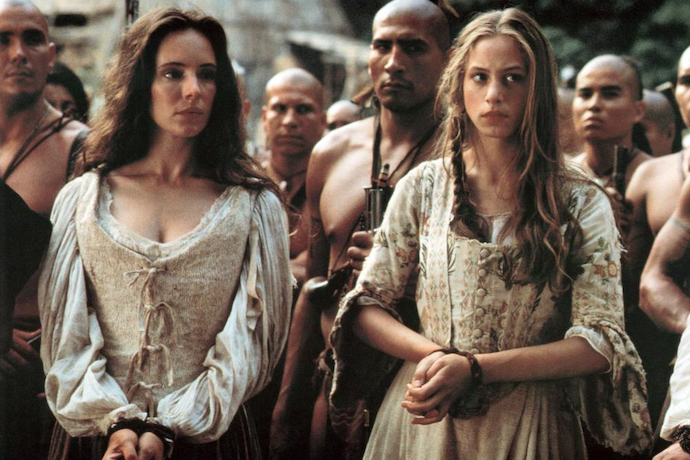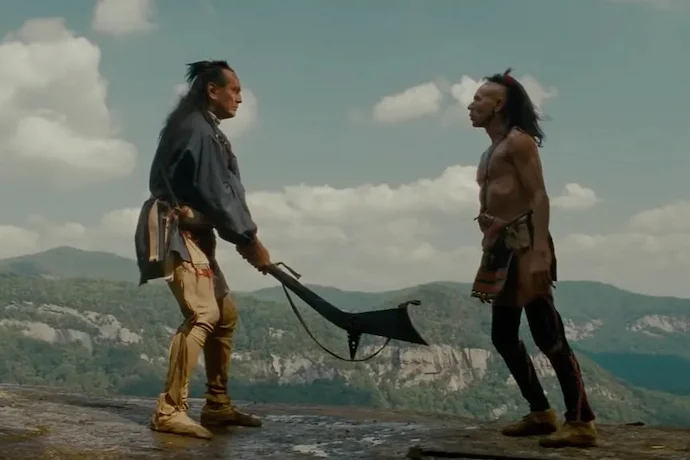
Will’s Core Canon: Why ‘The Last of the Mohicans’ Might Be Michael Mann’s Best
Welcome to Will’s Core Canon, a series covering some of my all-time favorite movies and why they work. This series seeks to go beyond surface-level analysis to strike at the core of why these films resonated the way they did.
Every year around my birthday, I like to revisit one of my favorite movies. This year, I could not be happier to have picked The Last of the Mohicans, 1992’s epic historic romance set in colonial America directed by Michael Mann and based on James Fenimore Cooper’s classic 1826 novel. This movie also credits a previous film adaptation from 1936 as a source of inspiration. The film follows Nathaniel “Hawkeye” Poe (Daniel Day-Lewis), the adopted son of Mohican warrior Chingachgook (Russell Means), in upper New York State during the French and Indian War.
A party escorting the two daughters of a commanding colonel is sabotaged, only for Hawkeye to step in and save them. The oldest daughter, Cora (Madeleine Stowe), and Hawkeye begin to bond as they return to the fort, only to find it under siege. The traitorous Mohawk warrior Magua (Wes Studi) seeks revenge against Cora’s father. Though they must be separated, Hawkeye pleads with Cora to stay alive and that he promises come what may, he will always find her. Lives are not spared as negotiations between the various warring parties take place on what to do with our cast of heroes.

Director Michael Mann has been discussed a lot recently, as his first movie in 8 years, Ferrari, was just released to positive reception. The Last of the Mohicans was Mann’s first bigger-budgeted movie, and only his fourth movie overall. He was mostly known before this for smaller thrillers like 1981’s Thief or 1986’s Manhunter, a prequel of sorts to The Silence of the Lambs that features Succession’s Brian Cox as none other than Hannibal Lecter.
Nowadays, 1995’s Heat is considered his masterpiece, with its cat-and-mouse chase, intense bank shootout, and iconic pairing of Pacino and De Niro, who shared the screen for the first time. I’m also privy to 1999’s The Insider, a tense recounting of the real-life story behind a whistleblower in the tobacco industry played by Russell Crowe, who received an Oscar nomination. You’re also likely to find fans of his movies like 2004’s Collateral or 2006’s Miami Vice, the latter of which Patrick Willems recently described as a “vibes movie.”
Though it is seldom discussed, it is my sincere belief that The Last of the Mohicans deserves a place as a foundational piece of Mann’s filmography, worthy to be included in the pantheon of great films he has directed. The cinematography is exquisite, where sweeping vistas of untouched frontier land feel at home next to more intimate shots of the characters’ expressions. To me, it recalls Stanley Kubrick’s Barry Lyndon and the sound design was impressive enough to earn an Oscar, to date the only one won by a Michael Mann film.
Before I get to the leads, I want to mention how much I enjoy supporting turns by the likes of Steven Waddington as Duncan, an army major attracted to but rejected by Cora who ends up self-sacrificing to save the lives of the new couple, and particularly Wes Studi, who excels at making Magua a compelling villain. Magua in his righteous indignation against newly arrived white settlers feels like the blueprint for a subsequent character like Killmonger in Marvel’s Black Panther. Daniel Day-Lewis had never played a role like this before, nor has he subsequently, but it ranks among my favorite performances by him. Hawkeye radiates confidence in his ability to walk between conflicting worlds, but he can also show off a vulnerable, tender side while with Cora.
Madeleine Stowe is radiant; she knows how to play to the camera and the camera loves to show off her magnetism. She displays a poise that I think would be played for naiveté if the character were written younger. Cora knows exactly what she wants, as evidenced by her rejection of Duncan. Both of the leads were in their 30s when filming, and their chemistry feels like a more mature one compared to star-crossed doomed young lovers, be they Veronese teenagers or on an ill-fated ocean liner. And unlike in those stories, these two get their happily ever after, but not without some losses along the way.
As always, I’m thinking about my beloved ‘90s, especially now that last year ended up being one of the major reappraisals of controversial ‘90s icons. At Thanksgiving, I found myself struggling at attempting to explain to my teenage cousin what going to Blockbuster Video was like or how big Friends was. I find myself asking if there is a reason movies like Teenage Mutant Ninja Turtles, Ghost, or recent National Film Registry inductees Home Alone and Terminator 2 feel distinctly ‘90s despite only coming out in the initial months of the decade. 1989’s Batman definitely feels like an ‘80s movie, but its sequel Batman Returns, released just three short years later, feels much more like a ‘90s movie.
But it almost feels to me like The Last of the Mohicans was just a little too ahead of its time. It reminds me a lot of movies like Titanic and Braveheart, both fellow epic historical romances which would rack up money at the box office and Oscars, including both for Best Picture, in the years after The Last of the Mohican’s release. Romance was a popular theme in the mid-to-late ‘90s: before Titanic, Leonardo DiCaprio made audiences swoon as Romeo in Baz Luhrmann’s contemporary retelling of Romeo + Juliet. Rom-coms starring the likes of Julia Roberts ruled the big screen.
Other big movies of the era were either decisively pro-America, like Independence Day or Air Force One, or recounted historic events in the nation’s history, like Apollo 13 or Saving Private Ryan. Even Disney got on the bandwagon, turning Pocahontas into a Disney princess complete with a handsome white male love interest voiced by Mel Gibson. The Mask of Zorro was another successful historical adventure with a romance at its core, albeit with a lighter, playful tone. At the beginning of the next decade, both The Patriot, also starring Mel Gibson, and Pirates of the Caribbean would depict stories that happened around the same time as The Last of the Mohicans to greater success.

So what’s the point I’m making? It’s weird to me that a movie that was decently received when it was initially released could have been an absolute sensation if released just a few years later, but that seems like the case here. Hear me out: it’s my theory that if it had been released, say, Memorial Day 1998, The Last of the Mohicans would have been a massive blockbuster and remembered much more fondly. Tie it to a hit song from a famous musician, the way Titanic and Armageddon did, and I think you’d have a certified cultural phenomenon on your hands.
I don’t think the studio knew what they had. Posters for the movie emphasized Daniel Day-Lewis in action-hero mode more than the romance. Had they known how to market it, which they would’ve learned post-Titanic, I can see the image of Hawkeye holding Cora as indelible to pop culture as Jack holding Rose on the bow of the famous ship.
Obviously, the Best Picture winner that feels like it most directly influenced the development of The Last of the Mohicans is Dances With Wolves, another epic historic romance with Native American characters. This is where I feel many dismiss the film because it feels dated, stewing in the early ‘90s reckoning of white creators writing white characters as our entry point to Indigenous culture. Our main character is blatantly stated to be a white man adopted by Native Americans, a plot point that probably wouldn’t pass snuff today, but should hardly be considered a strike against the film. After all, the character’s name was updated from the far more problematic “Natty Bumppo” in the original text. If anything, the production consulting with Indigenous historians and tribal leaders, and especially the casting of Native American actors like Studi, Means, and Dennis Banks should be applauded. Means and Banks were primarily known not as actors, but rather for their activism in the American Indian Movement.
The Last of the Mohicans also feels ‘90s because it’s something that feels like movies aren’t allowed to be anymore: sexy. The sexual tension between Day-Lewis and Stowe is palpable, as both actors know how to express so much with just a look or a touch. They are frequently depicted as soaking wet or under waterfalls, only enhancing the sexual imagery. Because of its nude scenes, Titanic feels like a PG-13 movie that should be rated R. In contrast, this movie feels like an R-rated movie that should be PG-13, because like in a PG-13 movie, the sexuality can only be so overt. Regardless, I think there is more passion and chemistry between our two leads in a single minute of this movie than there have been in the entirety of most blockbusters released in the past decade.
All that to be said, the film isn’t perfect. It doesn’t know what to do with Cora’s sister Alice (Jodhi May) or Hawkeye’s brother Uncas (Eric Schweig), so they, I guess, also have a love affair. Although it ends tragically, it can’t help but be dwarfed and overshadowed by the film’s central romance. These are characters that feel like they’re only here because they were in the original text. I would argue that in this version, they don’t add too much to the overall narrative. May claims much of her role ended up on the editing room floor, and I can see why. I feel like in a subsequent draft of the movie’s screenplay, Alice and Uncas would’ve been done away with entirely.
Nevertheless, I think I’ve done enough to argue for the merits of The Last of the Mohicans. My experience is that when you’re watching it, it’s so easy to be swept up in. Much credit for that has to be given to the score by Trevor Jones and Randy Edelman, enchanting and invigorating, particularly its main theme, “Promentory.” I didn’t give it proper credence in its initial viewing during a movie night in college where drinking beer was more the primary objective than watching the movie. But every subsequent time I’ve watched it has endeared me to it even more. So if you haven’t already, do yourself a favor and watch this quintessentially ‘90s classic, which represented a major career turning point for one of Hollywood’s most legendary directors.
